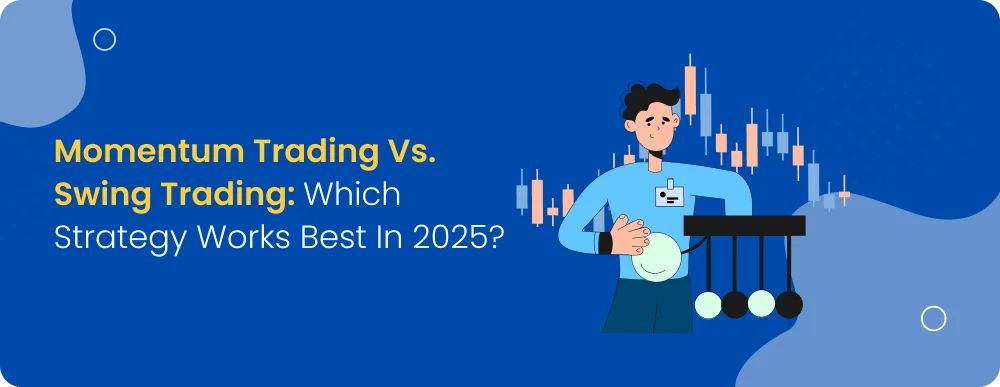Momentum Trading vs. Swing Trading: Which Strategy Works Best in 2025?
Noor Kaur
19 Mar 2025Tags:
Investing
Both momentum and swing trading focus on short-term price movements but follow different approaches. Momentum trading aims to capitalise on rapid price changes driven by strong market trends, while swing trading focuses on profiting from price swings over a few days or weeks.
Understanding the differences between these strategies will help you choose the right approach for your trading style.
What Is Momentum Trading?
Momentum trading involves purchasing stocks that are gaining momentum and selling stocks that are losing momentum. You rely on market trends and trading volume to assess stocks that are moving quickly in one direction. The goal is to enter a trade while momentum is strong and exit before the trend reverses.
- Holding period: A few minutes to several days
- Key focus: High volatility and fast-moving trends
- Best suited for: Traders who actively monitor price movements
- Indicators used: Relative Strength Index (RSI), Moving Averages, and Volume Weighted Average Price (VWAP)
What Is Swing Trading?
Swing trading focuses on capitalising on price swings (temporary increases or decreases in a stock's price). Instead of chasing fast-moving trends, you identify stocks likely to reverse direction and trade them accordingly.
- Holding period: Several days to a few months
- Key focus: Capturing short- to medium-term price swings
- Best suited for: Traders who prefer less frequent trades
- Indicators used: Fibonacci retracements, Bollinger Bands, and MACD (Moving Average Convergence Divergence)
Benefits of Swing Trading vs. Momentum Trading
Some benefits of swing and momentum trading are:
Feature | Momentum Trading | Swing Trading |
Time Commitment | Requires active monitoring | Less time-intensive |
Risk Level | Higher due to rapid price movements | Lower as trades last longer |
Profit Potential | Quick but smaller gains per trade | Larger gains per trade |
Ideal Market Conditions | Strong trends and volatility | Sideways or trend-reversal markets |
If you prefer fast trades and frequent action, momentum trading may suit you. However, swing trading could be a better fit if you like waiting for high-probability setups.
Momentum Trading vs. Swing Trading: Key Differences
While momentum trading relies on quick trades within hours or days, swing trading focuses on capturing bugger price swings over a few days or weeks. Let’s discuss these differences in detail.
Timeframe: Short-term vs. Medium-term
- Momentum trading is a short-term strategy where trades last a few minutes to a few days. You make multiple trades in a day, capitalising on strong price movements.
- Swing trading takes a medium-term approach, with trades held for several days to weeks. It focuses on predictable price swings rather than rapid market shifts.
Risk levels: High-risk (momentum) vs Moderate-risk (swing)
- Momentum trading carries a higher risk because prices can change rapidly. If the trend weakens, losses can mount quickly.
- Swing trading has moderate risk, as you have more time to analyse trends. However, holding positions overnight exposes you to market gaps (sudden price changes after the market closes).
Required skill sets and tools
- Momentum trading demands quick decision-making and precise execution. You need to be proficient in technical analysis and use indicators like the Relative Strength Index (RSI), Moving Averages, and Volume to track price momentum.
- Swing trading, however, requires patience and a strategic approach. Instead of reacting to immediate price movements, you focus on support and resistance levels to predict potential price swings.
Market conditions: When is each strategy most effective?
- Momentum trading works best in markets with strong trends and high volatility. The best stocks to swing trade in this strategy are those experiencing rapid price increases with high trading volumes.
- Swing trading is more effective in sideways or slightly trending markets, where price fluctuations create opportunities for buying at lows and selling at highs.
Economic Outlook and Market Trends in 2025
The stock market 2025 is expected to be shaped by interest rate policies, inflation trends, and global economic conditions. With technological advancements and increased participation from retail traders, market volatility could remain high, creating opportunities for short-term trading strategies like momentum and swing trading.
Moreover, sectors such as technology, renewable energy, and AI-driven businesses may see strong price movements, making them attractive to traders.
Suggested Read: Understanding Sectors Before Investing in Stocks | mastertrust
Factors that Favor Momentum Trading in 2025
Momentum trading thrives in markets with high volatility and strong price trends. In 2025, factors that could benefit momentum traders include:
- Increased market liquidity with more algorithmic trading participation
- Sector-specific rallies, especially in tech and AI-driven industries
- Favorable macroeconomic trends, such as easing interest rates and economic recovery, lead to strong bullish momentum
- Advanced trading technology allows for faster execution and real-time data analysis
Factors that Favor Swing Trading in 2025
Swing trading works well when markets experience short-term fluctuations within a broader trend. In 2025, key factors that support swing trading include:
- Market corrections and consolidation phases create predictable price swings
- Interest rate stability, reducing extreme volatility, and favouring technical analysis
- Earnings cycles and corporate actions, providing tradeable price movements
- More sophisticated technical tools make it easier to identify support and resistance levels
Which Strategy is Better Suited for Different Types of Traders
Your choice between momentum trading vs. swing trading depends on your risk appetite, time horizon, and trading style:
- Momentum trading is better suited for experienced traders who can handle high risk, react quickly to market movements, and use advanced trading tools. It requires constant monitoring and a strong grasp of technical analysis.
- Swing trading is ideal for beginner to intermediate traders who prefer a balanced approach with moderate risk. It allows for more flexibility and doesn’t require daily monitoring of trades.
Both strategies can be profitable if applied correctly, but it is crucial to understand market trends and align them with one's risk appetite.
Conclusion
Both momentum and swing trading offer opportunities in 2025, but the right choice depends on market conditions and your trading style. If markets stay highly volatile with strong trends, momentum trading could yield quick gains for experienced traders. Whereas, if price fluctuations are more controlled, swing trading may provide steady returns with lower risk. Align your strategy with your risk tolerance, time horizon, and skill level to maximise profitability.
FAQs
How long does a typical momentum trade last?
A momentum trade can last a few minutes to hours, depending on the trend's strength. Some momentum trading strategies may extend to a few days if the price movement remains strong. The goal is to capture rapid price changes, so traders constantly monitor momentum trading indicators like the Moving Averages and Relative Strength Index (RSI).
Can I use both momentum and swing trading in the same portfolio?
Many traders combine momentum and swing trading to balance risk and maximise profits. Momentum trading focuses on short-term price surges, while swing trading strategies aim for gains over days or weeks. Diversifying with both strategies allows you to take advantage of short-term market trends while maintaining longer-term positions in swing trading stocks and options.
How does market volatility impact momentum and swing trading strategies?
Momentum trading thrives in high-volatility environments where prices move quickly, allowing traders to enter and exit positions rapidly. Swing trading, on the other hand, benefits from moderate volatility, where price swings create clear entry and exit points. If volatility is too low, neither strategy may perform well due to a lack of price movement.
Are there specific sectors or industries better suited for momentum trading in 2025?
In 2025, momentum trading will likely perform well in sectors with high trading volumes and strong price trends. Due to rapid innovation and investor interest, technology, renewable energy, and AI-driven stocks may offer good opportunities for momentum trading strategies.
What are the most common mistakes traders make with momentum or swing trading?
Some common mistakes traders make with momentum or swing trading are:
- Many traders enter too many positions, especially in momentum trading, leading to losses from unnecessary risks.
- Sudden market reversals can wipe out gains in swing and momentum trading without stop-loss orders.
- Swing trading strategies require patience as one waits for entry and exit points. Impulsive decisions often lead to losses.
Do momentum and swing trading strategies work well in bull and bear markets?
Yes, but with adjustments. In a bull market, momentum and swing trading strategies can benefit from strong upward trends. In a bear market, momentum trading works well for shorting stocks, while swing trading may require a more cautious approach, focusing on the best stocks to swing trade with resilient price movements.
Noor Kaur
19 Mar 2025Related blogs


Intraday Trading Strategy: Open High Open Low Approach
Intraday trading is one of the most exciting and rewarding types of online stock trading. As a day trader, you sho...


Understanding NISM Certification : Everything You Need to Know | mastertrust
In today's world, more and more people are getting curious about finance and the world of money. It doesn't matter...


Seeking Better Returns Than FDs? Explore These Options | mastertrust
Fixed deposits are a popular investment choice because of their guaranteed returns and safety.


Role of Inflation in Long-Term Investment Planning
In Financial Planning, one of the things that plays a key role is the impact of inflation on your investments.
Sign up to our newsletter !
Share this article on
Recent articles
Tags:
Open a Demat Account in just 15 minutes !

Click on open
account below

Fill out some
basic details

Upload your
documents

Start trading in
24 Hours *
Commonly asked questions
Is Master Capital Services Limited SEBI registered?
Do you have a mobile app for Trading and Finance Management?
What services does mastertrust provide?
What is the minimum investment required to start trading with your company?
Is my personal and financial information secure with your company?
What is your customer support availability?





